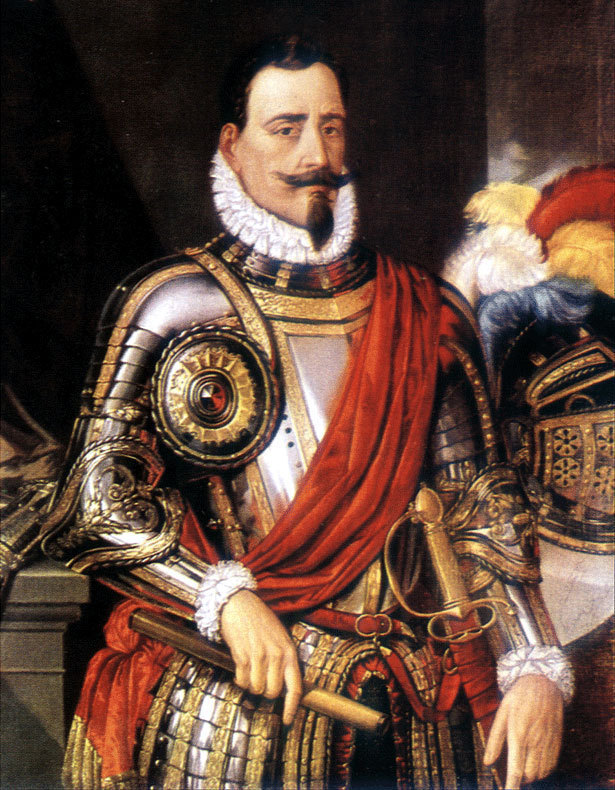 |
| Pedro de Valdivia |
Pedro de Valdivia, a Spanish conquistador, is best known as the conqueror of Chile. He was born about 1500 at La Serena, Estremadura, Spain. He joined the Spanish army at a time of near constant warfare in Europe.
As a soldier in the army of Charles V of Spain, Valdivia fought for the Habsburg empire in the Italian Wars. He saw action at Flanders and at Pavia in 1525.
The Battle of Pavia is particularly notable as the first major modern battle, illustrating the shift from knights in armor and crossbowmen to cannoneers.
  |
Valdivia went to the New World in 1535. He took part in the prolonged conquest of Venezuela and then joined Francisco Pizarro, the conqueror of Peru, in 1532. Conspicuous among the conquistadores for his learning and conceit, Valdivia became the most distinguished officer and the highest in rank in Pizarro’s government. He commanded Pizarro’s forces at the 1538 Battle of Las Salinas, a struggle between Pizarro and other conquistadores for control of the city of Cuzco.
Pizarro was a notoriously difficult man to the point where he was eventually assassinated by his fellow Spaniards, but Valdivia displayed an ability to get along with the conqueror and became his favorite. He received the title maestro del campo, or chief officer of staff, and appeared set for a prosperous life in Peru. However Valdivia had an ambitious nature. He wanted both an independent position and a territory of his own.
He picked Chile for reasons that baffled the other Spaniards. Chile had such a bad reputation after the failed expedition of Diego de Almagro that public opinion in Peru held that the land could not feed 50 Spaniards; there was no wealth to be had in Chile. Nevertheless, Valdivia sought Pizarro’s support to explore and conquer the land. In exchange, he surrendered his valuable encomienda and a silver mine at Porco.
 |
| Spaniards in Chile |
In 1539, Pizarro named Valdivia as lieutenant governor of Chile and Valdivia set out to claim his territory. Valdivia had great trouble recruiting men to accompany him in part because he possessed little property. The commander of an expedition in this era had to pay all the expenses involved with the movement of troops.
Since Valdivia had little money, he could afford only a small force. He left Cuzco in January 1540 with betweeen five and 20 Spanish soldiers, his mistress Inés de Suárez, and a Native American auxiliary force of about 1,000 men. Along the route to Arequipa, other Spaniards joined him.
At Tarapacá, Valdivia waited for additional reinforcements, but when the army finally set out across the Atacama desert, it numbered fewer than 100 Spaniards including two priests. Valdivia marched south with the items deemed most useful for colonization—European grains, principally wheat; domestic animals, especially pigs and fowl; and a collection of agricultural implements.
   |
After 11 months of hardship, skirmishes with Indians, and internal conflicts, Valdivia’s forces arrived in the valley of the Mapocho. Almost immediately they were attacked by an Indian army led by the local chief, Michimalonco.
The Spaniards eventually drove off the Indian warriors. At Copiapó, seven months after Valdivia’s journey had begun, he took possession of Chile in the name of the Spanish Crown. Soon after, he convinced the local Indians to aid in the construction of Chile’s first European-style city, Santiago, in February 1541.
Less than a month later, Valdivia created a cabildo (governing council), which in turn, called upon Valdivia to make himself governor of Chile in the name of the king of Spain rather than as Pizarro’s lieutenant. After perfunctory objections, Valdivia agreed. Unfortunately for the Spaniards, on September 11, 1541, the Araucanian Indians (Southwestern South America)attacked Santiago and burned it to the ground.
The war for Chile would consume the remainder of Valdivia’s life. He spent the next years pushing south from Santiago, warring against the Araucanians, and establishing a number of fort towns including Concepcion, La Imperial (present-day Carahue), Valdivia, and Villarrica.
With the creation of each city, Valdivia handed out encomiendas to selected conquistadores, thereby granting them authority to collect tribute from the Indians in their jurisdiction and take charge of the process of Christianizing the Native Americans.
Religious orders were also granted encomiendas by the conquistador. Since the indigenous Chileans had little accumulated wealth, tribute typically took the form of forced labor in the mines or gold washings.
Not surprisingly, the Indians put up a fierce resistance to enslavement. In 1548, Valdivia received aid and reinforcements from Peru, raising the number of Spaniards in Chile to 500 men. It would not be enough, since the Spanish troops were stretched so thinly throughout the country.
On December 25, 1553, the Araucanians were under the command of Lautaro, a former groom of Valdivia’s who had acquired knowledge of Spanish tactics and weaknesses during his time as a slave. Lautaro lured Valdivia into a trap. The Araucanians defeated the Spaniards in the Battle of Tucapel, killing Valdivia and all 50 of the men who had accompanied him.
Although legend holds that the Indians captured Valdivia and poured molten gold down his throat in reference to the wealth that he so brutally sought, it is more likely that his decapitated head ended up on the point of an Araucanian lance. This was the Indians’ customary treatment of conquered enemies.
Following Valdivia’s death, most of the Spaniards fled southern Chile for Santiago. The Spanish remained a presence only at the fort of Valdivia. Chile remained in a constant state of war until the 17th century.
